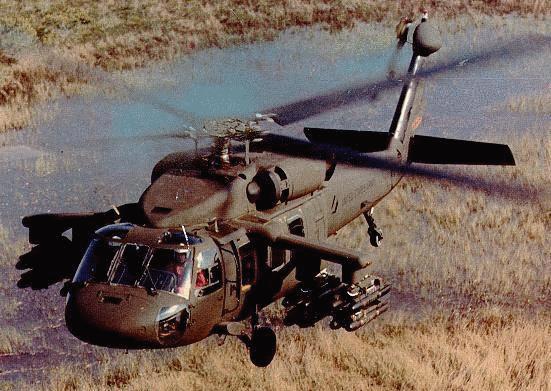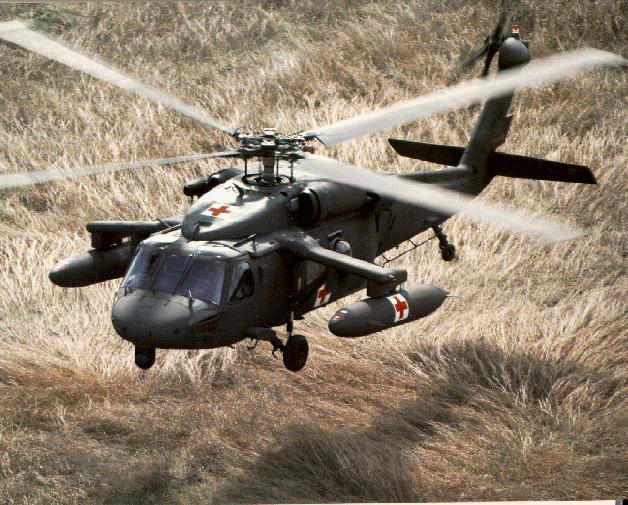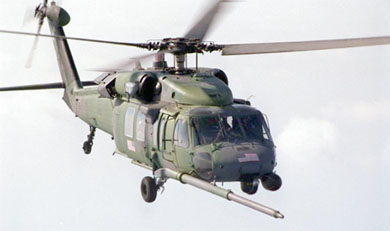

| Name | UH-60 "Black Hawk" (Sikorsky Aircraft Corp. ) |
| Type | Command and control, electronic
warfare, and special operations
platforms helicopter |
| Year | 1978 |
| Engine | Two T700-GE-701Cs |
| Length | 64 feet 10 inches(rotor turning) |
| Height | 16 feet 10 inches (overall) |
| Rotor Diameter | 53 feet, 7 inches (14.1 meters) |
| Weight | 11,500 pounds |
| Max. speed | 150 knots |
| Operational Range | 315 nm (internal fuel) |
| Crew | 3 Crew + 11 troops |
| Armament | Two 7.62mm mini-guns or
M-60 mg 7.62mm or M-240 mg 7.62 (optional) |
UH-60 Black Hawk
The Black Hawk is the Army’s front-line
utility helicopter used for air assault, air cavalry, and aeromedical evacuation
units. It is designed to carry 11 combat-loaded, air assault troops,
and it is capable of moving a 105-millimeter howitzer and 30
rounds of ammunition. First deployed in 1978, the Black Hawk’s advanced
technology makes it easy to maintain in the field.
The Black Hawk has performed admirably in a variety of missions, including
air assault, air cavalry and aeromedical
evacuations. In addition, modified Black Hawks operate as command and
control, electronic warfare, and special operations
platforms.
The UH-60A, first flown in October 1974, was developed as result of
the Utility Tactical Transport Aircraft System (UTTAS)
program. The UTTAS was designed for troop transport, command and control,
MedEvac, and reconnaissance, to replace the
UH-1 Series "Huey" in the combat assault role. In August 1972, the
U.S. Army selected the Sikorsky (model S-70)
YUH-60A and the Boeing Vertol (model 237) YUH-61A (1974) as competitors
in the Utility Tactical Transport Aircraft
System (UTTAS) program. The Boeing Vertol YUH-61A had a four-bladed
composite rotor, was powered by the same
General Electric T700 engine as the Sikorsky YUH-60A, and could carry
11 troops. In December 1976 Sikorsky won the
competition to produce the UH-60A, subsequently named the Black Hawk.
The Black Hawk is the primary division-level transport helicopter, providing
dramatic improvements in troop capacity and
cargo lift capability compared to the UH-1 Series "Huey" it replaces.
The UH-60A, with a crew of three, can lift an entire
11-man fully-equipped infantry squad in most weather conditions. It
can be configured to carry four litters, by removing eight
troop seats, in the MedEval role. Both the pilot and co-pilot are provided
with armor-protective seats. Protective armor on the
Black Hawk can withstand hits from 23mm shells. The Black Hawk has
a cargo hook for external lift missions. The Black
Hawk has provisions for door mounting of two M60D 7.62mm machine guns
on the M144 armament subsystem, and can
disperse chaff and infrared jamming flares using the M130 general purpose
dispenser. The Black Hawk has a composite
titanium and fiberglass four-bladed main rotor, is powered by two General
Electric T700-GE-700 1622 shp turboshaft engines,
and has a speed of 163 mph (142 knots).
Elements of the US Army Aviation UH-60A/l Blackhawk helicopter fleet
will begin reaching their sevice life goal of 25
years in 2002. In order for the fleet to remain operationally effective
through the time period 2025-2030 the aircraft will
need to go through an inspection, refurbishment, and modernization
process that will validate the structural integrity of the
airframe, incorporate improvements in sub-systems so as to reduce maintenance
requirements, and modernize the mission
equipment and avionics to the levels compatible with Force XXI and
Army After Next (AAN) demands.
A Service Life Extension Program (SLEP) is planned for the UH-60 beginning
in FY99. The UH-60 modernization program
will identify material requirements to effectively address known operational
deficiencies to ensure the Black Hawk is equipped
and capable of meeting battlefield requirements through the 2025-2030
timeframe. Primary modernization areas for
consideration are: increased lift, advanced avionics (digital communications
and navigation suites), enhanced aircraft survivability
equipment (ASE), increased reliability and maintainability (R &
M), airframe service life extension (SLEP), and reduced
operations and support (O & S) costs. Suspense date for the approved
Operational Requirements Document (ORD) is
December 1998.
Variants
The Army began fielding the UH-60 in 1978. From 1978 until 1989 the
Army procured UH-60A model aircraft. In October
1989, a power train upgrade resulted in a model designation change
from UH-60A to UH-60L. The UH-60L version that
provides 24 percent more power than the original 1970 UH-60A model.
As of the end of FY97, the Army had procured 483
UH-60L models for a total UH-60 acquisition of 1,463 aircraft. The
Army is in the fifth and final year of a multi-year
procurement contract calling for the delivery of 60 aircraft per year.
UH-60L. In October 1989, the engines were upgraded
to two General Electric T700-GE-701C 1890 shp turboshaft
engines, and an improved durability gear box
was added, resulting in a model designation change from UH-60A to
UH-60L. The T700-GE-701C has better high altitude
and hot weather performance, greater lifting capacity, and
improved corrosion protection.
UH-60 Firehawk is a Reseach and Development
program to provide the UH-60 series helicopter with both a wartime
and peacetime fire fighting capability by
use of a detachable 1,000 gal. belly tank. Qualification issues include
design and
testing required to maintain the combat capabilities
of the UH-60 Black Hawk and the safe flight envelope of the aircraft
with the tank.
EH-60A Electronic Countermeasures (ECM) variant
has a unique external antenna designed to intercept and jam enemy
communications. The EH-60E is powered by two
General Electric T700-GE-700 1622 shp turboshaft engines.
EH-60B version was a Stand-Off Target Acquisition
System designed to detect the movement of enemy forces on the
battlefield and relay the information to a
ground station.
UH-60Q MEDEVAC

The UH-60Q MEDEVAC helicopter provides significant enroute patient care
enhancements. The UH-60Q provides a 6
patient litter system, on-board oxygen generation, and a medical suction
system. UH-60Q is a UH-60A derivative and
incorporates approximate UH-60A characteristics. It is simply the best
in aeromedical evacuation. Building on the BLACK
HAWK's heritage of saving lives in Grenada, Panama, Kuwait and Somalia,
the UH-60Q delivers exceptional patient care,
increased survivability, longer range, greater speed and added missions
capability. For military combatants. War victims.
Civilians injured in natural disasters. It has a state-of-the-art medical
interior that can accomodate a crew of three and up to six
acute care patients. The UH-60Q's leading-edge technology incorporates
an improved environmental control system. Cardiac
monitoring systems. Oxygen generation, distribution and suction systems.
Airway management capability. Provision for stowing
IV solutions. And an external electrical rescue hoist. And in addition
to extensive immediate care, the UH-60Q can perform all
weather terrain battlefield evacuation, combat search and rescue, hospital
ship lifeline missions, deep operations support,
forward surgical team transport, medical logistics resupply, medical
personnel movement, patient regulating,
disaster/humanitarian relief, and MAST/HELP state support.
The UH-60Q's medical interior can accomodate three to six acute care
patients and their medical attendants. Ergonomic design
has maximized the UH-60Q cabin space, placing sophisticated, life-saving
instruments and equipment at the fingertips of the
medical attendants. A unique platform design allows the interior to
transport either six litter of seven ambulatory systems,
oxygen distribution and suction systems, airway management capability,
and provisions for stowing intravenous solutions. The
interior also features these additional capabilities, essentical to
providing the highest degree of patient care when every second
counts:
Oxygen Generating Systems
NVG Compatible Lighting Throughout
Environmental Control System
Medical Equipment
Patient Monitoring Equipment
Neonatal Isolettes
Modernizing the Medical Evacuation (MEDEVAC) system is the Army Surgeon
General's number one near term priority. The
UH-60Q communications architecture provides situational awareness and
digital communications and is expected to be the
model for anticipated fleet-wide improvements to the UH-60. Other improvements
include integrated Doppler/GPS, Personnel
Locator System, NVG interior lighting, and FLIR.
MH-60G Pave Hawk
The Pave Hawk is a twin-engine medium-lift helicopter operated by the
Air Force Special Operations Command, a component
of the U.S. Special Operations Command. The MH-60G's primary wartime
missions are infiltration, exfiltration and resupply of
special operations forces in day, night or marginal weather conditions.
Other missions include combat search and rescue.
During Desert Storm, Pave Hawks provided combat recovery for coalition
air forces in Iraq, Saudi Arabia, Kuwait and the
Persian Gulf. They also provided emergency evacuation coverage for
U.S. Navy sea, air and land (SEAL) teams penetrating
the Kuwait coas t before the invasion.
The MH-60G is equipped with an all-weather radar which enables the crew
to avoid inclement weather. To extend their range,
Pave Hawks are equipped with a retractable in-flight refueling probe
and internal auxiliary fuel tanks. Pave Hawks are
equipped with a rescue hoist with a 200-foot (60.7 meters) cable and
600-pound (270 kilograms) lift capacity. All MH-60G's
have an automatic flight control system to stabilize the aircraft in
typical flight altitudes. They also have instrumentation and
engine and rotor blade anti-ice systems for all-weather operation.
The non-retractable landing gear consists of two main landing
gears and a tail wheel. Aft sliding doors on each side of the troop
and cargo compartment allow rapid loading and unloading.
External loads can be carried on an 8,000-pound (3,600 kilograms) capacity
cargo hook. Pave Hawks are equipped with
folding rotor blades and a tail stabilator for shipboard operations
and to ease air transportability.
MH-60K is the standard special operations version
of the Black Hawk. It is capable of providing long-range airlifts far
into hostile territory in adverse weather
conditions. Modifications include two removable 230 gallon external fuel
tanks,
two .50 cal. machine guns, an air-to-air refueling
probe, and an external hoist. The MH-60K can also be armed with
two M134 7.62mm "miniguns". A new avionics
suite includes interactive Multi-Function Displays (MFDs),
Forward-Looking Infrared (FLIR), digital map
generator, and terrain avoidance/terrain following multi-mode radar.
Survivability equipment includes radar and
missile warning systems and IR jammers. The MH-60K has full shipboard
operability. It is powered by two General
Electric T700-GE-701C 1843 shp turboshaft engines.
The older MH-60L can be adapted to the attack
mission by attaching dual weapons pylons to both sides of the fuselage.
Pylon mounting cannon, rockets, or missiles
can be supplemented by door or port mounting guns or launchers, limited
mainly by the range, duration, cargo, or troops
required to complete the mission. The helicopter's mission is insertion
and
extraction of special operations troops. Survivability
equipment includes radar and missile warning systems and IR
jammers. The MH-60L is powered by two General
Electric T700-GE-701C 1843 shp turboshaft engines.
HH-60G Pave Hawk

The mission of the HH-60G Pave Hawk is to provide the capability of
independent rescue operations in combat areas up to
and including medium-threat environments. Low-level tactical flight
profiles are used to avoid threats. Night Vision Goggle
(NVG) and Forward Looking Infrared (FLIR) assisted low-level night
operations and night water operation missions are
performed by specially trained crews. A radar warning receiver, infrared
jammer, Hover Infrared Suppression System
(HIRSS), chaff dispenser, and precision navigation equipment (GPS,
Inertial Navigation System (INS), Doppler) afford
additional threat avoidance and protection. The helicopter has limited
self-protection provided by side window mounted
machine gun. The helicopter hoist can recover survivors from a hover
height of 200 feet above the ground or vertical landings
can be accomplished into unprepared areas. The maximum speed is 193
knots with a cruise speed of 120 to 140 knots.
Unrefueled range is 480 nautical miles (NM), with a combat load and
aircraft at maximum gross weight of 22,000 lbs; the
combat radius is approximately 200NM. Inflight refueling greatly extends
this range.
The aircraft is capable of independent operations in combat areas up
to and including medium-threat environments. Recoveries
are made by landing or by alternate means, such as rope ladder or hoist.
Low-level tactical flight profiles are used to avoid
threats. Night Vision Goggle (NVG) assisted low-level operations and
night water hoist missions are performed by specially
trained crews. An APR-39A(V)1 radar warning receiver, ALQ-144A infrared
jammer, Hover Infrared Suppression System
(HIRSS), M-130 chaff dispenser, and precision navigation equipment
(GPS, Inertial Navigation System (INS), Doppler)
afford additional threat avoidance and protection. The helicopter has
limited self-protection provided by M-60, M-240, or
GAU-2B machine guns. The helicopter hoist can recover a Stokes litter
patient or three people simultaneously on a forest
penetrator from a height of 200 feet above the ground. The basic crew
normally consists of five: pilot, co-pilot, flight engineer,
and two PJs. The maximum speed is 193 knots with a cruise speed of
120 to 140 knots. Unrefueled range is 480 nautical miles
(NM), with a combat load and aircraft at maximum gross weight of 22,000
lbs; the combat radius is approximately 200NM.
HH-60G is rapidly approaching its flying hour service life limit. Consequently,
CAF will soon require either a service life
extension program (SLEP) for HH-60G or procurement of a replacement
aircraft for conducting CSAR operations. The
HH-60G System Program Office (WR-ALC/LU) is assessing whether HH-60G’s
service life limit is 8,000 flight hours, IAW
the Army specification for the H-60 airframe, or actually closer to
7,000 flight hours based upon AF configuration and
operating gross weights of the HH-60G. Depending on the assessment
results, HH-60G aircraft (1981 models) will begin
reaching their service life limit as early as FY00, if service life
limit is determined to be 7,000 flight hours. Otherwise, if the limit
is determined to be 8,000 flight hours, 1981 model HH-60G aircraft
will begin reaching their service life limit in FY03.
CH-60 Sea Hawk
The current Fleet Combat Support Helicopter provides the Navy's Combat
Logistics Force (CLF) with an at-sea Vertical
Replenishment (VERTREP) capability. It also serves as the primary Search
and Rescue (SAR) helicopter for the Amphibious
Task Force (ATF), providing essential support to amphibious operations.
The primary missions of the CH-60 will include day
and night VERTREP, day and night amphibious SAR, vertical onboard delivery,
and airhead operations. Secondary missions of
the CH-60 will include Combat Search and Rescue (CSAR), Special Warfare
Support (SWS), recovery of torpedoes,
drones, unmanned aerial vehicles, and unmanned undersea vehicles, noncombatant
evacuation operations, aeromedical
evacuations, humanitarian assistance, executive transport, and disaster
relief. The CSAR/SWS version of the CH-60 will have
additional mission equipment installed that will provide the Navy with
capabilities for CSAR and SWS in both the active
carrier-based Helicopter Antisubmarine Squadrons (HS) and in the Reserve
Helicopter Combat Support (Special) (HCS)
Squadrons.
Based on the current deployment schedule, the CH-60 will first replace
the H-46D helicopters in active Navy Helicopter
Combat Support (HC) Squadrons. After the H-46s have been replaced,
the CH-60 will replace the HH-60H helicopters in the
Reserve HCS squadrons, then the UH-3H and HH-1H helicopters used as
Naval Air Station SAR, range support, and
executive transport missions. Finally, the CH-60 will replace the HH-60H
helicopters in active Navy HS squadrons.
The CH-60 will be able to operate day or night, under adverse weather
conditions, including flight in light icing. The helicopter
will be compatible with all current and future Aircraft Carriers, CLF,
and ATF ships to include fitting inside the hangars of all
CLF ships without ship alteration. The helicopter will be capable of
operating over all designated ship hover areas, both day
and night, and be compatible for limited operation aboard both aviation
and air capable ships proportionate with a fixed
fore-to-aft wheelbase of 29 feet.
The CH-60 will be an Army UH-60 Blackhawk utility airframe in combination
with Navy SH/HH-60 transmissions and
dynamic components. The CH-60 will incorporate new design items that
are not in use by either the UH-60 or SH/HH-60
airframe lines. The CH-60 will adapt the Naval H-60 Tail Pylon to the
Blackhawk tail cone with a CH-60 unique canted
bulkhead at the tail cone, tail pylon interface. This bulkhead will
“marry” the two components by providing a Naval H-60
interface on its aft face to accommodate the Naval H-60’s fold hinges
and quick disconnect mechanism; and a UH-60 interface
on its forward face to accommodate the UH-60’s tail landing gear and
tail cone interface. The Blackhawk’s tail cone flight
controls will be rerouted to accommodate the Naval H-60 rapid fold
tail pylon.
Source-fas.org